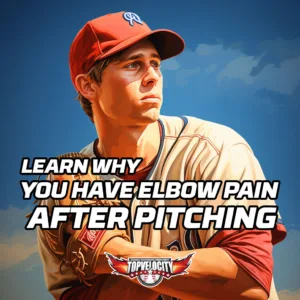 Are you searching for the answers to the questions Why Does My Elbow Hurt After Pitching then this is the article for you!
Are you searching for the answers to the questions Why Does My Elbow Hurt After Pitching then this is the article for you!
Baseball, commonly referred to as "America's pastime," demonstrates both skill and athleticism. In the midst of the exhilaration of pitches, swings, and catches, a nagging issue hangs over the players' heads: the potential of elbow injuries. In our quest to understand the complexities of this problem, we look into not one, but two critical studies that offer a complete explanation of the causes of elbow injuries in baseball players.
These studies function as complementing puzzle pieces, each offering insight into a different facet of the problem. One study focuses on technical concerns, methodically studying the subtleties of pitching mechanics, while the other focuses on tiredness, investigating how the strain of prolonged play impacts the players' performance and health.
We will travel through the findings of this research as we embark on this adventure of discovery, interpreting the role of mechanics and tiredness in the occurrence of elbow injuries. We hope to build a clearer picture of the various elements that contribute to elbow injuries in baseball players by combining their thoughts. Whether you're an aspiring pitcher, a devoted coach, or simply a fan of the game, this exploration of scientific studies will broaden your awareness of the sport's issues and potential answers. So, let us go on this illuminating adventure to unravel the intricate tapestry of elbow injuries in baseball.
Mechanical Timing Issues: Why Does My Elbow Hurt After Pitching
Pitching is a biomechanically complex motion involving a series of coordinated movements. Pitchers' throwing methods vary, particularly in timing-related variables like pelvis rotation, arm cocking, stride leg movement, and pitch delivery time. A critical study sought to clarify the links between these variables by studying pitchers with varying pelvic rotation patterns (Wight et al., 2004). Based on their pelvis orientation during stride foot contact, pitchers were classed as 'early rotators' (pelvis orientation greater than 30°) or 'late rotators' (pelvis orientation less than 30°).
Early vs. Late Rotators: Kinematic and Temporal Differences
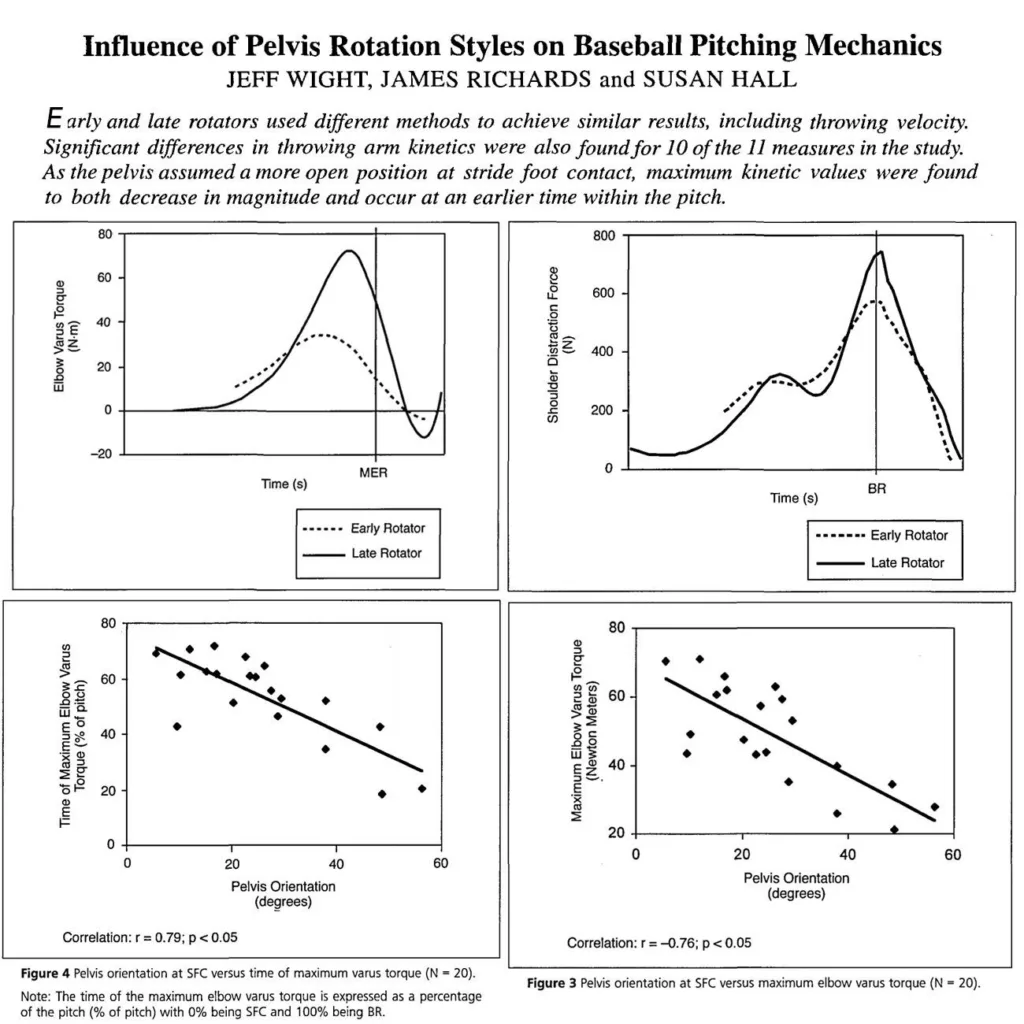
During the arm cocking phase, the researchers discovered intriguing kinematic and temporal differences between early and late rotators. Early rotators had more shoulder external rotation at the instant of stride foot contact, an earlier occurrence of maximal pelvis rotation angular velocity, and a shorter time to complete this phase. Despite these discrepancies, both groups converged at the moment of maximum shoulder external rotation, with similar pelvic and arm positions. This implies that early and late rotators use different approaches to attain comparable results, such as throwing velocity.
The Elbow Connection in Throwing Arm Kinetics
The enormous forces and stress imposed on the elbow joint during the throwing motion are typically ascribed to elbow soreness after pitching. The research found substantial differences in throwing arm kinematics between the two methods. In particular, 10 of 11 measures differed significantly. Maximum kinetic values were shown to decrease in amplitude and occur sooner inside the pitch when the pelvis assumed a more open position at stride foot contact. This discovery throws light on how alterations in pitching mechanics, namely pelvic orientation, can affect the pressures exerted on the throwing arm and, as a result, contribute to elbow discomfort.
Muscle Fatigue: Why Does My Elbow Hurt After Pitching
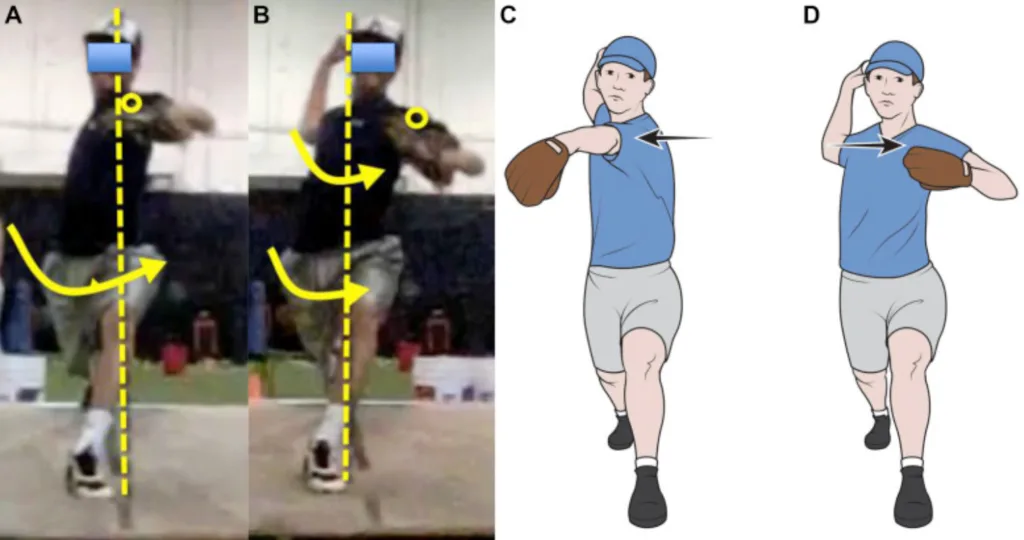
Understanding the delicate relationship between muscle exhaustion and the risk of elbow injury in baseball is critical for enhancing performance and protecting player well-being. A significant study investigated this dynamic by studying the effects of a simulated baseball game on adolescent pitchers (Erickson et al., 2016). Let's look at the important findings that shed light on the link between muscle exhaustion and the risk of elbow injury.
Overview of the Research on Why Does My Elbow Hurt After Pitching
The study included 28 participants who were excellent youth pitchers ages 13 to 16. These pitchers, who had an average age of 14.6 years, had 6.3 years of throwing experience and threw around 94 pitches every week. The goal was to examine how pitching mechanics, velocity, accuracy, and pain perception change during a simulated game.
Investigating Fatigue and Pain Progression
A definite trend formed among the pitchers as the simulated game progressed. The findings demonstrated that as the pitch count climbed, the pitchers' fatigue levels grew gradually. On a visual analog scale, perceived fatigue increased from a low of 0.3 to a high of 3.5. Along with exhaustion, reported pain levels increased, demonstrating that prolonged gameplay added to discomfort. As the scores increased from 0.1 to 1.6, so did the shift in pain perception.
Muscle Fatigue and Pitching Mechanics
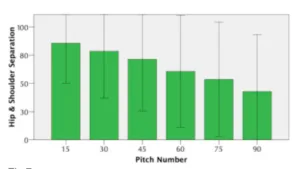 The research looked into the intricate mechanics of pitching, notably the musculature involved. A noteworthy finding was that core and leg musculature appeared to be affected once tiredness set in before any changes in upper extremity kinematics were noticed. Knee flexion upon ball release increased with pitch number, indicating that lower body muscles are involved in pitching motion maintenance. There was also a significant drop in hip and shoulder separation as the pitch count increased. The image above of the four pitches gives a visual understanding of this mechanical breakdown.
The research looked into the intricate mechanics of pitching, notably the musculature involved. A noteworthy finding was that core and leg musculature appeared to be affected once tiredness set in before any changes in upper extremity kinematics were noticed. Knee flexion upon ball release increased with pitch number, indicating that lower body muscles are involved in pitching motion maintenance. There was also a significant drop in hip and shoulder separation as the pitch count increased. The image above of the four pitches gives a visual understanding of this mechanical breakdown.
Strengthening Strategies' Role
The potential for injury prevention is a significant implication of these findings. Because the core and leg musculature showed symptoms of exhaustion before the upper extremity kinematics changed, the study implies that strengthening these areas could be beneficial in minimizing the likelihood of upper extremity injuries. Pitchers may improve their general musculoskeletal integrity by implementing specific exercises targeting the core and legs, potentially relieving the strain on the elbow joint.
Future Research on Why Does My Elbow Hurt After Pitching
While this study provides useful information, it also highlights the need for additional devoted research to completely understand the intricate relationship between muscle fatigue and elbow injury risk. Understanding the mechanisms behind these associations will pave the way for evidence-based training programs that improve both pitching proficiency and player longevity as the baseball community continues to prioritize player health and performance optimization.
In conclusion, this study sheds light on the intricate links between muscle exhaustion and the risk of elbow injury in adolescent pitchers. Baseball may take proactive efforts toward injury prevention and sustainable athletic greatness by recognizing the progression of fatigue, the function of pitching mechanics, and the need for strengthening strategies.
Improve Your Game with the 3X Velocity Camp
Two crucial components stand as pillars of success in the pursuit of excellence on the baseball diamond: flawless mechanics and powerful physical conditioning. As we've dug deeper into the many components that contribute to elbow injuries, it's clear that addressing these features is critical to not only improving performance but also protecting against possible harm.
The 3X Velocity Camp is a game-changing program that will improve your game by sharpening your mechanics and protecting your body against injury. This camp emerges as your partner in unlocking your full potential, with a wealth of information drawn from years of experience, research, and hands-on involvement in the baseball world.
Precision in Every Pitch: Mastering Mechanics
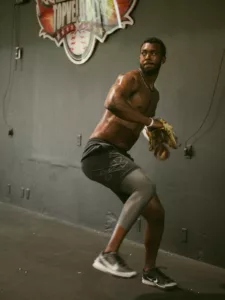 Pitching mechanics lay the groundwork for repeatable and effective performance. Our camp places a high value on teaching you through the complexities of correct mechanics. You'll study each step of your pitch, led by experts in the physics of movement, to ensure precision, efficiency, and force. Whether you're a pitcher looking to improve your delivery or a player looking to expand your knowledge of the game, our emphasis on mechanics enables you to throw pitches with accuracy and velocity.
Pitching mechanics lay the groundwork for repeatable and effective performance. Our camp places a high value on teaching you through the complexities of correct mechanics. You'll study each step of your pitch, led by experts in the physics of movement, to ensure precision, efficiency, and force. Whether you're a pitcher looking to improve your delivery or a player looking to expand your knowledge of the game, our emphasis on mechanics enables you to throw pitches with accuracy and velocity.
Strength and Conditioning for Resilience
However, mechanics alone cannot guarantee long-term success. Baseball demands a physique that is not just agile but also durable. Our 3X Velocity Camp will provide you with a solid foundation of strength and fitness. You'll acquire the core strength, muscular endurance, and agility required to flourish in the fast-paced world of baseball through specialized exercises and individualized training programs.
Unveiling the Injury Defense Shield
Our dedication extends beyond performance enhancement to injury prevention. The 3X Velocity Camp protects you from elbow problems by targeting both mechanics and physical conditioning. Proper mechanics limit unnecessary stress on your joints, while a well-conditioned physique functions as a shield, absorbing the stresses of intense gameplay. Your journey with us is about more than simply improving your performance—it's about ensuring you walk onto the field with confidence, knowing you've taken proactive efforts to protect your health.
Participate in the 3X Velocity Camp Today!
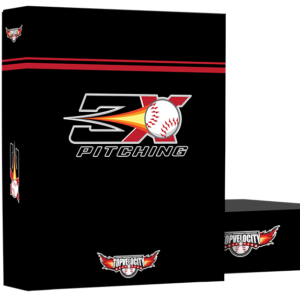 Are you ready to take your game to the next level? The 3X Velocity Camp beckons, promising a revolutionary experience that combines mastery of mechanics with powerful fitness. When you enter our camp, you are not only accepting an opportunity to improve your talents; you are also entering on a journey of growth, empowerment, and injury resilience.
Are you ready to take your game to the next level? The 3X Velocity Camp beckons, promising a revolutionary experience that combines mastery of mechanics with powerful fitness. When you enter our camp, you are not only accepting an opportunity to improve your talents; you are also entering on a journey of growth, empowerment, and injury resilience.
Secure your position in the 3X Velocity Camp and join a community dedicated to breaking barriers, adopting science-backed training, and emerging as a force to be reckoned with on the baseball field. Your future in the game is calling—answer it with the strength of mechanics, training, and an unwavering desire to excel.
Checkout TopVelocity Patreon for more exclusive content on this subject with remote coaching and weekly video analysis!
FAQs: Why Does My Elbow Hurt After Pitching
Q: Is elbow soreness typical after pitching?
A: Due to the repetitive and high-impact nature of pitching, many pitchers endure elbow pain.
Q: Can proper pitching mechanics lessen the likelihood of elbow pain?
A: Without a doubt. Correct pitching mechanics can greatly reduce stress on the elbow joint and reduce the likelihood of soreness.
Q: How might Top Velocity programs assist pitchers in avoiding elbow pain?
A: Brent Pourciau's Top Velocity programs focus on science-backed ways to improve performance while reducing the risk of injury.
Q: Are there any exercises I can do to strengthen my elbow and prevent pain?
A: Yes, focused workouts that strengthen the muscles around the elbow joint can help with stability and pain relief.
Q: How important is time in elbow pain?
A: Timing, specifically pelvic rotation and arm mechanics, can affect the forces exerted on the elbow joint during the pitching motion.
Q: Can late rotators use early rotator pain-prevention techniques?
A: While the two types use distinct methodologies, understanding the mechanics of both can help you optimize your pitching techniques and reduce elbow discomfort.
Reference:
Erickson, B. J., Sgori, T., Chalmers, P. N., Vignona, P., Lesniak, M., Bush-Joseph, C. A., ... & Romeo, A. A. (2016). The impact of fatigue on baseball pitching mechanics in adolescent male pitchers. Arthroscopy: The Journal of Arthroscopic & Related Surgery, 32(5), 762-771.
Wight, J., Richards, J., & Hall, S. (2004). Baseball: Influence of pelvis rotation styles on baseball pitching mechanics. Sports Biomechanics, 3(1), 67-84.




